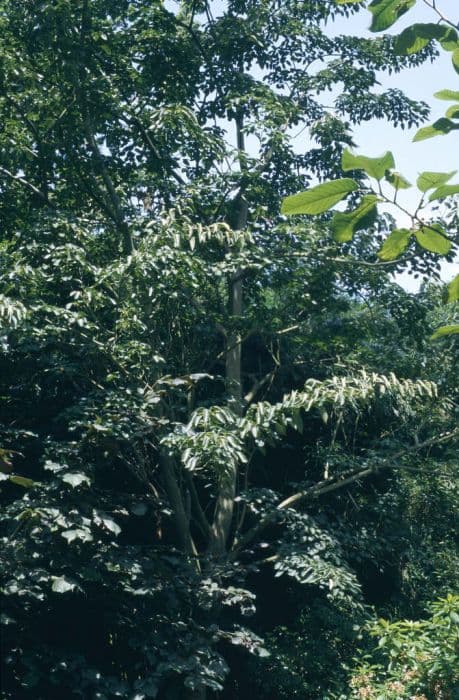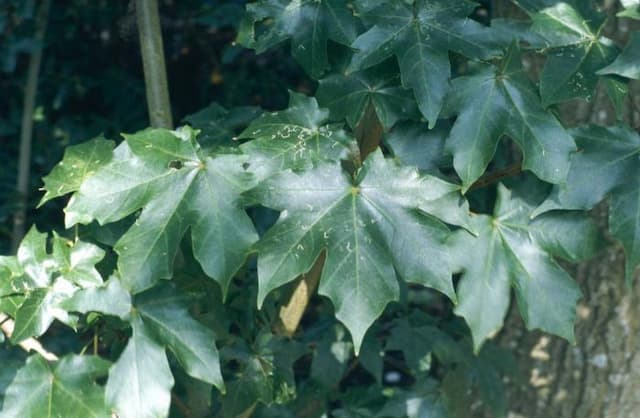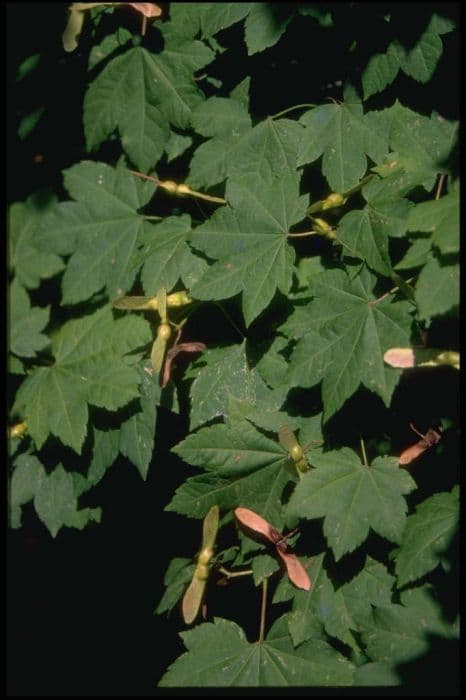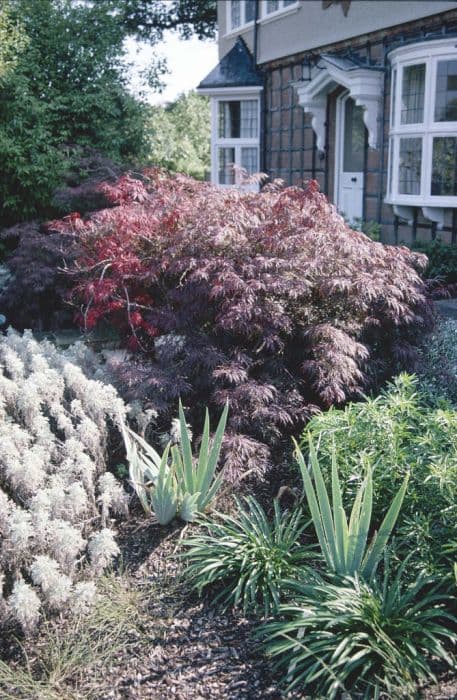Japanese Maple Acer palmatum 'Chiyo-hime' (Dw)
ABOUT
Acer palmatum 'Chiyo-hime' is a variety of Japanese maple that is well-regarded for its ornamental appeal. This plant is noted for its delicate appearance, with fine-textured foliage that stands out in any garden setting. The leaves are intricately shaped, characterized by their lobed form, which typically features five to seven pointed lobes that spread out like the palm of a hand, hence the common name palmatum. During different seasons, the leaves of 'Chiyo-hime' undergo a magnificent transformation. In spring, the foliage emerges with a vibrant light green hue that shines brightly against the contrasting darker branches. As the seasons progress, the leaves take on tones of yellow and gold, creating an eye-catching display. In the fall, the foliage may shift to show off hues of red and orange, providing a spectacular autumnal show. The branches of this Japanese maple are elegantly arranged and have a smooth appearance that adds to its refined aesthetic. Young stems may display a reddish color, which provides an additional ornamental feature. Overall, 'Chiyo-hime' has a compact and rounded shape that contributes to its popularity among gardeners who value its graceful form and changing colors throughout the seasons.
About this plant
 Names
NamesFamily
Sapindaceae
Synonyms
Chiyo-hime Japanese Maple, Dwarf Chiyo-hime Japanese Maple
Common names
Acer palmatum 'Chiyo-hime'.
 Toxicity
ToxicityTo humans
Japanese maple, including the 'Chiyo-hime' cultivar, is generally not toxic to humans. There are no commonly reported symptoms of poisoning from ingesting this plant, as it is not considered poisonous. Typically, it does not pose a threat if touched or ingested in small quantities. However, consumption of any plant material may cause discomfort or an allergic reaction in some individuals, so it is always advisable to avoid eating plants that are not specifically grown for consumption.
To pets
Japanese maple, specifically the 'Chiyo-hime' cultivar, is generally considered to be non-toxic to pets. It is not known to cause poisoning in cats, dogs, or other household pets. There are no well-documented symptoms associated with the ingestion of this plant by pets. However, ingestion of plant material can sometimes lead to gastrointestinal upset in animals, so it is prudent to prevent pets from consuming parts of this ornamental plant.
 Characteristics
CharacteristicsLife cycle
Perennials
Foliage type
Deciduous
Color of leaves
Varies
Height
4 feet (1.2 meters)
Spread
3 feet (0.9 meters)
Plant type
Shrub
Hardiness zones
6
Native area
Japan
Benefits
 General Benefits
General Benefits- Compact Size: Ideal for small gardens or spaces, as it does not grow too large.
- Aesthetic Appeal: Enhances garden beauty with its delicate leaves and attractive shape.
- Seasonal Interest: Offers vibrant fall colors, providing visual interest through the seasons.
- Shade Provider: Creates cool, shaded areas in the garden during hot summer months.
- Erosion Control: Its root system can help prevent soil erosion in the landscape.
- Wildlife Habitat: Can provide shelter and some food sources for birds and insects.
- Low Maintenance: Requires minimal pruning and upkeep once established in the landscape.
- Urban Tolerant: Adapts well to urban conditions, including pollution and limited soil space.
 Medical Properties
Medical PropertiesThis plant is not used for medical purposes.
 Air-purifying Qualities
Air-purifying QualitiesThis plant is not specifically known for air purifying qualities.
 Other Uses
Other Uses- Miniature Bonsai Art: The Acer palmatum 'Chiyo-hime' is commonly used for creating miniature bonsai due to its small leaves and compact growth, allowing enthusiasts to craft intricate and detailed miniature landscapes.
- Photography: Photographers often seek out 'Chiyo-hime' due to its striking foliage and form, making it a favorite subject for botanical and artistic photography projects.
- Culinary Presentations: Some chefs use the delicate leaves of the Japanese maple as ornamental garnishes for plating high-end cuisine, adding a touch of elegance to their dishes.
- Education and Demonstration: This plant is used by educators to illustrate principles of pruning and plant growth habits in horticulture and botany courses.
- Seasonal Decoration: The vibrant autumn colors of 'Chiyo-hime' make it a popular choice for fall decorations both indoors and in garden settings.
- Feng Shui: Some practitioners of Feng Shui may use 'Chiyo-hime' in their garden designs to balance energies and create a sense of well-being.
- Cultural Festivities: In Japanese-themed festivals, branches of 'Chiyo-hime' may be used as part of the decor to celebrate Japanese culture and the changing seasons.
- Wedding Ceremonies: 'Chiyo-hime' can be integrated into wedding ceremonies as part of the floral arrangements, particularly in outdoor or garden-themed weddings.
- Ink Production: The leaves of 'Chiyo-hime' could potentially be used as a natural source of dye for inks, given their rich color (though this is not a common practice).
- Artistic Inspiration: Artists may use the form and texture of the Japanese maple as inspiration in paintings, sculptures, and other forms of art.
Interesting Facts
 Feng Shui
Feng ShuiThe Japanese Maple is not used in Feng Shui practice.
 Zodiac Sign Compitability
Zodiac Sign CompitabilityThe Japanese Maple is not used in astrology practice.
 Plant Symbolism
Plant Symbolism- Elegance: The Acer palmatum 'Chiyo-hime', commonly known as Japanese Maple, is often associated with elegance due to its delicate leaves and fine branching structure.
- Peace: Its serene appearance often lends itself to symbolize tranquility and peace in gardens and landscapes.
- Balance: The balanced growth habit of the Japanese Maple and its aesthetic harmony are evocative of equilibrium and stability in life.
- Endurance: Despite its delicate appearance, the Japanese Maple is a hardy plant that can withstand varying conditions, representing endurance and resilience.
- Change: Because the leaves of the Japanese Maple change color with the seasons, they often symbolize change and the cycle of life.
 Water
WaterThe Japanese maple, particularly the 'Chiyo-hime' variety, should be watered regularly to maintain evenly moist soil, especially during dry spells. In the first growing season, it's crucial to establish a good root system, so water it deeply once a week with about 2 gallons of water per session. After establishment, reduce watering frequency but ensure the tree receives roughly 1.5 gallons per week, unless rainfall is sufficient to maintain soil moisture. During hot or windy weather, the soil may dry out faster, and additional watering may be necessary. Always check the soil moisture by touching the soil; it should be moist, not saturated or bone dry.
 Light
LightJapanese maples, including 'Chiyo-hime', thrive in partial shade to full sun, but in areas with hot summers, they benefit from afternoon shade to prevent leaf scorch. The best spot for the 'Chiyo-hime' maple is one where morning sunlight can reach the leaves but is then protected during the harsh, hot afternoon hours. Dappled sunlight under the canopy of larger trees can also be an ideal location for these delicate maples.
 Temperature
TemperatureThe 'Chiyo-hime' Japanese maple prefers moderate temperatures, with an ideal range between 60°F and 80°F. It can survive in temperatures as low as -10°F but needs protection from harsh winter winds and extreme cold. In summer, it's important to shield the maple from intense heat above 90°F to prevent stress on the plant. Consistently maintaining temperatures within its comfort zone will ensure healthy growth.
 Pruning
PruningPrune your 'Chiyo-hime' Japanese maple to shape it, remove any dead or damaged branches, and to encourage a strong structure. The best time to prune is late winter or early spring before new growth starts. Light pruning can also be done in summer if necessary. Typically, these trees are pruned once a year, but corrective pruning can be undertaken anytime as needed.
 Cleaning
CleaningAs needed
 Soil
SoilJapanese Maple 'Chiyo-hime' thrives in a well-draining, acidic to neutral soil mix with pH between 5.5 and 7.0. A good mixture often contains one part peat, one part pine bark, and one part coarse sand or perlite to ensure proper drainage and aeration. Regularly monitoring the soil's moisture level is key, ensuring it remains moist but not wet.
 Repotting
RepottingJapanese Maple 'Chiyo-hime' should be repotted every 2-3 years or when the roots outgrow the pot. Younger trees may require repotting more frequently, while mature specimens can be repotted less often. The best time for repotting is in late winter or early spring before new growth starts.
 Humidity & Misting
Humidity & MistingJapanese Maple 'Chiyo-hime' prefers moderate to high humidity levels, generally around 60-80%. It doesn't tolerate dry air well, so maintaining consistent humidity is important for its growth and leaf health. Misting the foliage or using a humidity tray can help maintain the appropriate levels indoors.
 Suitable locations
Suitable locationsIndoor
Place in bright, indirect light and ensure high humidity for indoor 'Chiyo-hime'.
Outdoor
Provide dappled sunlight and protect from harsh conditions for 'Chiyo-hime' outdoors.
Hardiness zone
5-9 USDA
 Life cycle
Life cycle'Chiyo-hime' Japanese Maple begins its life as a seed, which once germinated, produces a small seedling with characteristic miniature leaves. As a juvenile, the tree grows slowly, developing its root system and branching structure. After a few years, it reaches the sapling stage, gradually maturing into an adult tree that can reach up to 6-8 feet tall, with a dense canopy of deeply lobed, reddish-green leaves known for seasonal color changes. Throughout its adult life, it undergoes annual cycles of growth, leaf expansion in the spring, followed by flowering and the development of winged samaras ("helicopter" seed pods) which disperse in the wind. During the fall, the foliage turns to vibrant shades of yellow, orange, and red before the leaves drop, leading the tree into dormancy during the winter months. With proper care, 'Chiyo-hime' can live for several decades, possibly over a century, before eventually succumbing to old age or environmental stressors.
 Propogation
PropogationPropogation time
Spring-Early Summer
The Japanese Maple 'Chiyo-hime' is most commonly propagated through softwood cuttings. This technique is usually undertaken in the early to mid-summer when the new growth is mature enough to sustain itself yet young enough to root easily. A grower would take a cutting of about 4 to 6 inches (10 to 15 centimeters) from a healthy branch, strip off the lower leaves, and then dip the cutting end into a rooting hormone for better chances of success. This is followed by planting the cutting into a well-draining soil mixture and ensuring it's kept in a humid environment with ample indirect light. Rooting can take several weeks, during which the cuttings should be kept moist but not waterlogged to prevent rot. Once rooted, cuttings may be potted into individual containers to grow on before being transplanted into the landscape.









